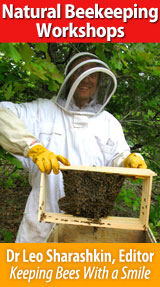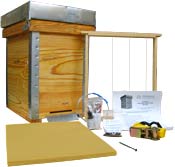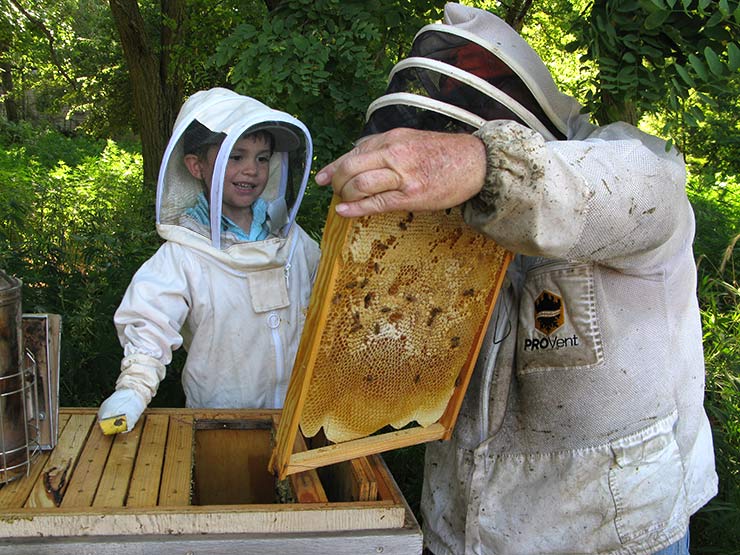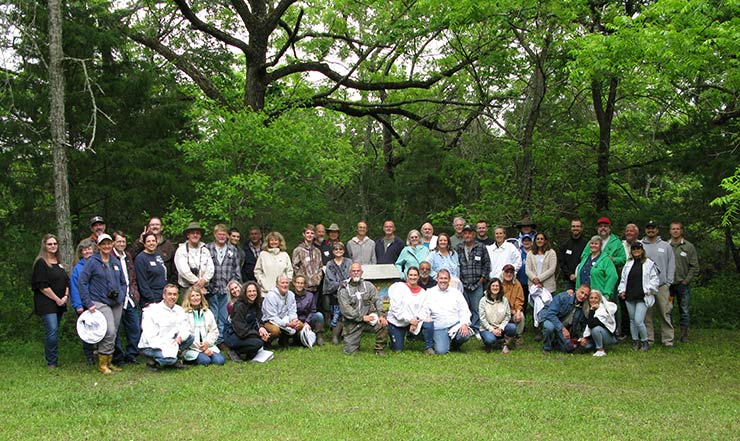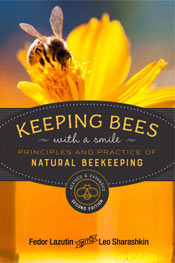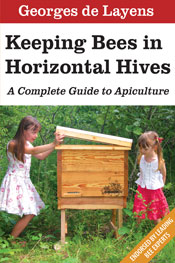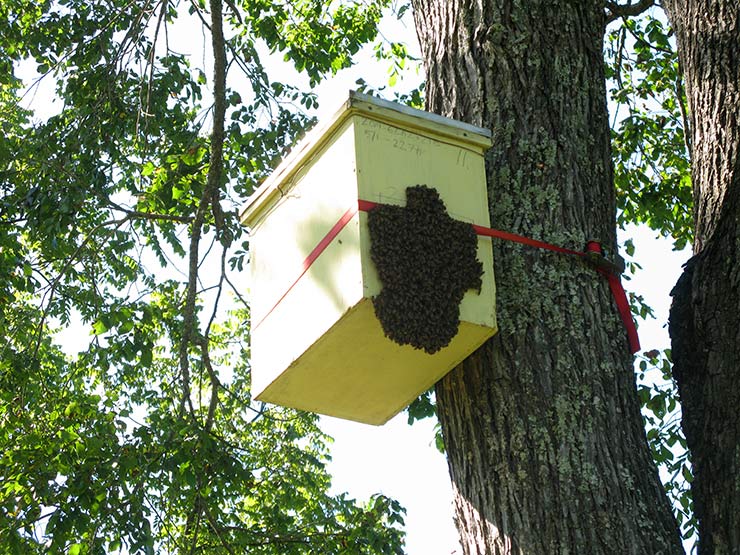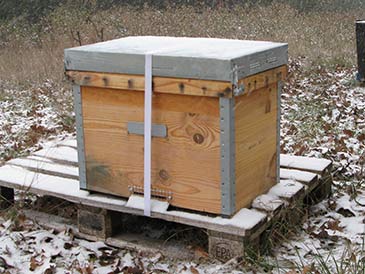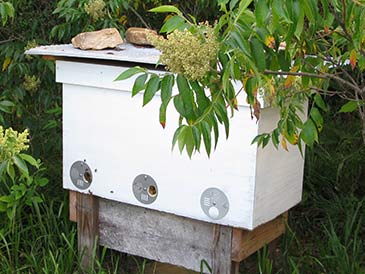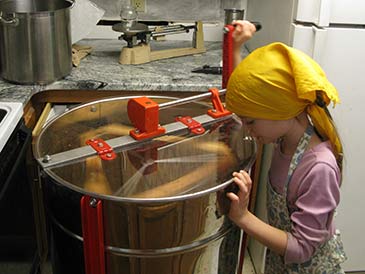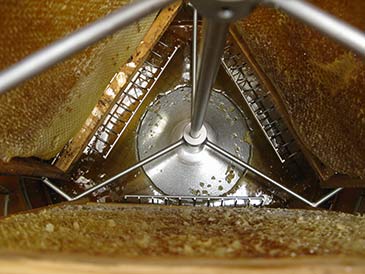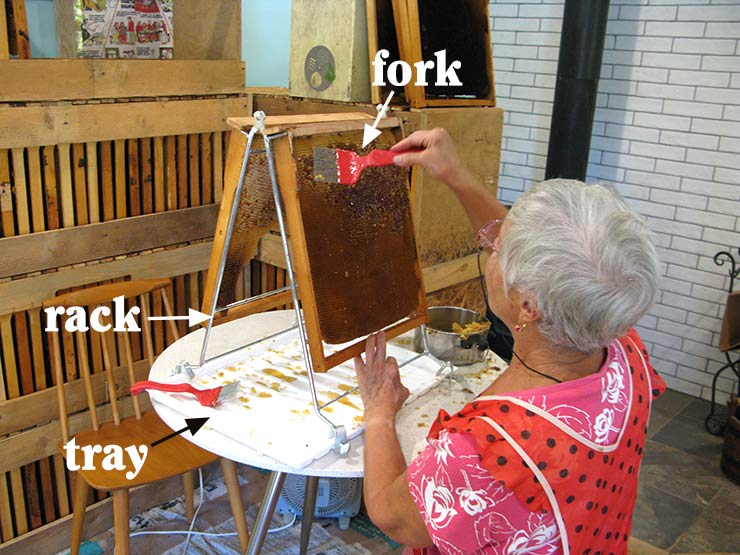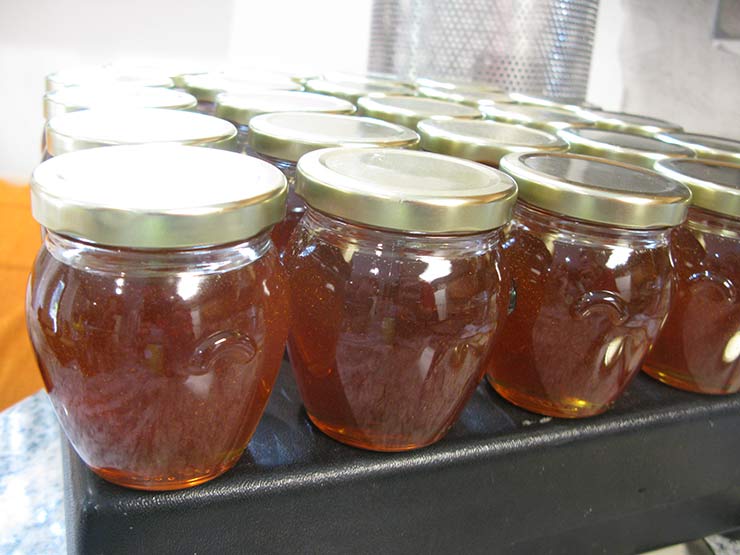“Smart Bees Hive Honey” — Getting Started in Natural Beekeeping
LAYENS HIVES and EQUIPMENT AVAILABLE FROM OUR STORE >>
Hives include all frames, fully assembled & ready to go
Getting started in natural beekeeping is as easy as Zero – One – Two – Three!
Here’s your magic formula for success: Smart Bees Hive Honey.
0. SMART
Behold a typical learning curve of a beginner beekeeper: You blow a good sum on expensive bees and equipment. Package bees arrive and thank God they weren’t smothered in transit. With awe and trepidation you dump your precious bees into the neat white box you prepared for them, and sigh a sigh of relief when they move in and make it their home. Then follows a short roller-coaster ride of trying to keep them alive. Then your bees die and you hang it up. Lesson learned: save yourself the heartbreak and it’s cheaper to buy honey than to keep your own bees.
But hope dies last, and some people repeat that cycle a few times before giving up, with the same sad result.
A minority of beginners stick it out, get a mentor, experiment, and eventually become reasonably good at making honey laced with chemicals and sugar syrup. It helps that you can buy sugar syrup at 50 cents per pound, and sell your great local honey at the farmers market for $10/lb, but even so, the whole thing is not nearly as enjoyable or rewarding as you had hoped. And if you take stock of all the expenses (including your time), then store-bought honey is still cheaper than what your bees can produce. That’s why many people buy commercial honey in bulk (it’s really cheap), then bottle and sell it under their own label.
This whole situation is so typical that the great British beekeeper R.O.B. Manley was writing: as a beginner, you have resources but no knowledge. You eventually gain experience, and now you have knowledge... but no resources — you squandered them all while learning! This was echoed by Julian Lubieniecki, whose 1859 book begins with the words: “Honey is made of knowledge. Be smart and you’ll have bees, hives, honey, and profit. Be ignorant and you’ll spoil and lose everything.” Amen.
So everything begins with your knowledge and understanding. Don’t think of it as “the first step,” because you need it before making any steps at all. Let’s call it “Step Zero,” or perhaps even “ground zero,” as you’ll have to demolish some of the “truths” you might have heard from practicing beekeepers, such as “you must treat bees with chemicals,” “feeding bees sugar is OK,” “Varroa mites are a problem,” etc.
Natural Beekeeping Workshops with Dr. Leo
A great way to learn natural beekeeping is to come to one of our Natural Beekeeping Workshops at Dr. Leo’s apiaries in Missouri. In just two days, you learn a ton of practical details, see active horizontal hives inside and out, get all your questions answered, and meet 50 co-minded beekeepers from a dozen different states, Canada, and Europe. The seminar gets you off to a good start, saving you years of trial and error. Take some equipment home in your car and you’ve offset registration fees by saving on shipping. Despite the cost, the seminar is the most economical option, helping you succeed and avoid costly mistakes down the road. Here is an update from one of the class participants:
- “Dr. Leo, I captured 98 swarms last spring and then took down my traps before I caught anymore, I had all I needed. I had 135 hives out of 137 survive the winter and they look strong going into spring. Thank you for the help you have given me while starting keeping bees.”
- — Tom T., Kansas
1. BEES
If you live in Wisconsin and want to plant an apple tree, you’ll order a sapling from a local nursery rather than from Florida or California. It only makes sense that locally acclimated plants (or animals) would do much better than those from a completely different locale.
The same applies to honey bees. Local wild bees are much more disease-resistant and are in sync with the blooming of local flowers. In one experiment reported in American Bee Journal, Dr. Tom Seeley (Cornell University) found the survival rate of bees with local wild genetics to be four times higher than for commercial bees with an Italian queen.
This is why Fedor Lazutin was writing (Keeping Bees with a Smile, p. 44):
- “By buying non-local bees or queens, you’re dooming yourself to constantly buying new queens down the road, along with treatments for numerous diseases. Your apiary will keep costing you money and will remain dependent on queen breeders, stores, and cash on hand. And if at any point you lose control, you’ll be bee-less before you know it.”
Georges de Layens had the same message 100 years before Lazutin:
- “Do not fall for passing fads that can cause serious harm. Do not use non-local bees in your apiary.”
How do you get local bees? Beekeepers who raise bees treatment-free and sugar-free from their own local stock are few and far between (by the way, a tremendous business opportunity for a profitable, nature-based family business). So the most practical and economical way of obtaining amazing survivor-stock bees is to catch local swarms using swarm traps.
Bee colonies have one queen that lays all the eggs, surrounded by her children: thousands of female workers and a few hundred drones (males that fertilize queens from other hives). Bee colonies propagate by swarming: before a new queen hatches from her cell, the old mother queen and half the bees from the hive fly off in a swarm and find a new empty cavity to establish their home. Hang a few small hives (called swarm traps) on trees come spring, and many of them will attract free local swarms. It really works (see Tom’s testimonial above); in fact, this is exactly how people have been obtaining free bees for their hives throughout history and throughout the world. See more detail in our free swarm-catching guide and in the instructions for using swarm traps.
There’s a tremendous difference between investing into swarm traps vs. buying bees. When you buy commercial bees and they die, you’ve wasted your money and you need to buy bees again — your beekeeping strains your marriage, drains your resources, and becomes a cash cow for bee breeders and suppliers of toxic treatments for sick bees. Hear what a lifelong commercial beekeeper from Michigan, Gerald Hanninen, has to say:
- “One of the most disappointing aspects of my beekeeping was the simple fact that my operations were never self-sustaining. There was always this flaw in the basic beekeeping principles as practiced here in the US.”
On the other hand, when you spend money on a swarm trap, you get an affordable tool that will supply you with free bees for 20+ years. When we started our apiary in southern Missouri, we went from zero hives to 50 hives in a few years without buying any bees — now that is some serious return on investment for a few $99 wooden boxes. The way I see it: take good care of the bees and the bees will take good care of you. Or, as R.O.B. Manley was writing, there’s a big difference between keeping bees and being kept by bees. As one of Britain’s largest honey producers, he proudly placed himself in the second category and you should, too, from the very beginning.
Here’s a reality check: the cost of a package of Italian bees from the same commercial supplier that showed only 14% survival rate in Dr. Tom Seeley’s experiment: $190 (as of January 2023) with expected useful life less than 1 year, no equipment included in the price — you’ll have to buy a hive separately (plus sugar syrup and chemicals to try to keep these zombees alive). The cost of our heavy-duty swarm trap, delivered (if you buy 5 at a time): $129, with expected useful life of 20 years, plus it can serve as a starter hive after the swarm moves in. Now that you are well informed, make your bets.
What you need to catch swarms
- Swarm traps, qty: 5. We recommend starting with five swarm traps — you maximize your chances of catching a swarm and get the largest possible discount. Very heavy duty — will exceed your expectations, and includes all frames, too.
- Wax foundation, one pack of 14 sheets, to install into the frames. Enough even for 5 swarm traps (30 frames) if you cut wax sheets in half.
- Swarm lure kit — one kit enough to scent five swarm traps with a smell attractive to swarms; the slow-release tubes in the kit are reusable, and there’s enough lure to last 5 years of swarm-catching.
- Propolis, one bag enough for 4 swarm traps. This is another fragrant swarm attractant.
- Feeders, qty: 2. In an unfavorable year feeding your swarm will save it from starvation, so it’s good to have a couple feeders on hand.
TOTAL COST, DELIVERED (as of January 2023): $719, or only $144 per trap including all supplies (wax and lure). Feeder cost not included in this calculation.
Don’t need five traps? Buy a complete swarm trap kit ($229 plus shipping) which includes everything you need to get started.
You can also build swarm traps and frames using our free plans, but I couldn’t match the quality of our heavy-duty traps in my home wood shop, plus the cost of materials and hardware is currently so high that it makes total sense to buy complete swarm traps ready to go.
A few more thoughts on swarm catching:
First, not every swarm will survive — the weak are culled, the strong are left to thrive and reproduce. The survival of your swarms will likely be higher than in nature, but it would be completely unnatural if every weak swarm survived! The good news is that you can afford to let this selection run its course (because you did not pay good money for the non-viable bees) and the quality of your stock will keep improving without costing you money.
Second, it’s extremely important to obtain bees with locally adapted genetics, and swarm traps are a simple and affordable tool to achieve this goal. But once you have the right sort of bees in your hives, you don’t have to depend on swarm traps for increasing your apiary. You’ll have an option to propagate your bees yourself right in your apiary by making artificial swarms (see Layens’s book).
Third, if you have any beekeepers within 2 miles of where you hang your swarm trap, you may catch a swarm from their hives, not from the wild. However, a swarm from a managed hive is still better than a store-bought package of bees: it’s free and its very existence means the mother colony survived the winter and was strong and healthy enough to reproduce naturally. The lack of local adaptation in such swarms can later be addressed through management. The good news, too, is that you may catch a wild swarm even in a city because there are plenty of wild colonies living in tree hollows, walls, and other man-made structures.
2. HIVE
You caught an awesome swarm in you swarm trap — congratulations! Now let’s give your bees a good home. Swarms grow quickly and may outgrow the swarm trap box within 3 weeks — that’s your window of time to move them into a bigger permanent hive so they have room to expand and make you honey.
The choice of hive models is thoroughly discussed in Keeping Bees with a Smile and in Keeping Bees in Horizontal Hives. We use, recommend, and sell Layens horizontal hives. We also have free plans for building insulated and solid wood Layens. All our Layens hives are directly compatible with the Layens swarm traps discussed above. The principal difference in hive models is capacity, mobility, and insulation, which also affects the cost.
We sell Layens horizontal hives holding 12, 14, 20, and 25 frames. They all have an expected useful life of over 20 years and offer exceptional value to suit your budget and priorities:
- 12 and 14 frames — Economical and easy to move. • Requires additional insulation and more frequent management. • Ideal for quickly expanding the apiary without breaking the bank.
- 20-frames — Natural wool insulation offers bees best protection. • Large hive volume — fewer visits needed. • Requires 2 people to move. • Despite the higher cost, this is our most popular hive model and our top recommendation — needs minimal care and provides best habitat for the bees.
- 25-frames — Extra-large capacity for honey-rich locations and more advanced management. • Very heavy — only for stationary apiaries. • Will benefit from additional insulation in very cold climates.
Hive volume
The difference in hive volume is also discussed in our FAQ article If Bees Run out of Room. Here’s the gist of it:
After transfer from the swarm trap into the permanent hive, the colony will keep building new comb, growing more bees, and stockpiling honey and pollen reserves. Strong swarms will commonly outgrow a 12-frame or 14-frame hive in the first summer, but they rarely outgrow a 20-frame or a 25-frame box in the first summer. So if you use a smaller-capacity hive (12 or 14 frames), plan to split these colonies before the hive gets overpopulated or harvest a few honey frames, spin out honey, and return empty combs to the colony to refill. Splitting a colony (recommended), you create two or three colonies out of one — this is why it is called “artificial swarming” (see details in Keeping Bees in Horizontal Hives and in Raising Honeybee Queens). Don’t need so many hives? You can always sell your surplus bees for very good money, or unite them back into super strong honey-producing colonies (see Afterword to Keeping Bees with a Smile).
So if you would like to quickly increase the number of your hives, buy a 12-frame or 14-frame hive and be prepared to manage them more frequently. For a more hands-off approach, emphasis on honey production, and if you don’t need to quickly grow the number of your hives, use a 20-frame or 25-frame hive.
An example with 12-frame hive:
- May 1 — you catch a strong swarm.
- May 7 — transfer bees into a 12-frame hive (and put the swarm trap back in the tree to catch another swarm).
- June 15 — the hive is completely full. Take every other frame (with bees and all) and move them into another 12-frame hive.
- Both colonies will keep growing (and whichever has no queen after the split will raise one), and by the end of the summer you’ll have two strong colonies and will harvest some honey from each.
- In the spring of year 2 you will split each surviving colony, doubling the number of your hives. And all this geometric expansion started with just one swarm.
An example with 20-frame hive:
- May 1 — you catch a strong swarm.
- May 7 — transfer bees into a 20-frame hive (and put the swarm trap back in the tree to catch another swarm).
- Every two weeks — add more frames as needed until full.
- By the end of the summer you’ll have a very strong colony and a large honey crop.
- Note that in the second year of your beekeeping, an overwintered colony will likely outgrow even the 20-frame hive, so you will either make artificial swarms (recommended) or repeatedly harvest honey — see the FAQ If Bees Run out of Room.
A 25-frame hive can accommodate a very large colony, and can be used to produce large crops of honey using techniques described in the Afterword to Keeping Bees with a Smile. Also, the 25-frame hive has enough room to house two medium-size colonies and to use advanced methods such as the two-queen system (two colonies separated by queen excluders work together to quickly fill central frames with honey, which are repeatedly extracted and returned to the bees to refill).
An important consideration: you can always make a big hive smaller by using a dummy board, but you cannot easily expand a small hive when full.
Hive mobility
The 12-frame and 14-frame hives are much more lightweight and can be moved by one person. Lifting a 20-frame hive takes two people, and a 25-frame hive is practically immovable. So the smaller hives are more suitable for more intensive hive management, and the bigger hives — for a more hands-off approach.
Hive insulation
Our 12-frame and 14-frame hives are made of solid wood just under 3/4” thick. The 20-frame Layens hive is double-wall insulated with 1-1/2” of natural wool. The 25-frame hive is built of solid wood 1-1/16” thick.
The 20-frame insulated hive protects bees from extreme cold, extreme heat, and wild temperature fluctuations. We have happy customers using this model everywhere from Texas to Alaska.
The solid-wood hives (especially the 12-frame and 14-frame) require additional insulation to keep bees warm in winter, plus additional precautions from overheating in summer. For more detail, see FAQ guides on Wintering and on Overheating prevention.
Be ready
Sometimes swarms arrive so quickly it’s overwhelming. So always have at least one empty hive ready to accept a swarm.
Cost-saving tip — treat your empty hives as swarm traps
Do not let your empty hives sit idly in your garage. Limit their volume to 7 frames using a divider board (swarms love that volume), add swarm lure, and set it outside on a stand. Swarms prefer cavities elevated 10 ft off the ground (this is why you place swarm traps in trees), but they can also move straight into your hive.
What should I get
- Hives of your choice.
- Foundation — sheets of wax to put into frames. We recommend using half-sheet in each swarm trap frame (so 3 sheets per trap), and a full sheet in each hive frame. If you envision a large number of hives and swarm traps, get a full 22-lb box of foundation — you save 20% and it keeps many years. If you don’t need as much foundation, buy the required number of 14-sheet bundles.
- Wool pillow — one per hive. Unless you live in a climate with no freezing weather in winter, the wool pillow placed on top of the frames is the best way to keep your bees warm. You can use an old wool blanket or sweater instead, but we don’t recommend synthetic materials such as polyester batting or Styrofoam as they trap moisture.
3. HONEY
In most years a strong early swarm will collect enough honey for their own wintering and to pay rent to you the beekeeper. As discussed in our wintering guide, leaving too much honey in the hive is not recommended — you can safely harvest and use the surplus.
Honey extractor is the only essential tool for honey harvest, and it’s not just about removing honey from frames without damaging the wax combs. Yes you could cut honeycomb out with a knife and enjoy it as-is (comb honey) or crush and strain it to obtain liquid honey and wax — no extractor necessary. But when you extract honey and store the empty (“dry”) comb over the winter, it comes very handy the following spring: you can add it to the hive and give the queen more room to lay eggs and produce more bees — the hive population will expand much quicker compared to when no empty comb is available. A stronger hive population will produce more honey, or you can split it in several parts (artificial swarms) and make multiple hives out of one. So the greatest utility of a honey extractor is giving you an inventory of empty-comb frames which are essential for increasing the number of your hives and/or producing more honey.
Unless you dislike turning the handle or have a very large number of hives, the hand crank extractor is all you need (it’s not hard — a 7-year-old child can do that). The motor extractor offers a similar quality of extraction, but it saves time: while it is spinning, you can be uncapping the next load of frames. Despite its high cost, an extractor is not an expense, but an investment. Our Europe-made extractors hold their value well, and quickly pay back with the growing number of colonies and greater honey harvest.
The only other tools (optional) are an uncapping rack to hold the frames while you remove the wax caps covering the honey cells, and a tray that the rack mounts to to catch the dripping honey. This setup is very convenient but optional: you can hold frames with your hand and use any cookie sheet to catch the drips. A variety of uncapping tools are available — from a simple kitchen knife or fork to special wide uncapping forks, rollers that puncture the seals instead of removing them, and knives (including heated and vibrating models). We use inexpensive uncapping forks available online.
IN SUMMARY
We want you to succeed and recommend the following cost-effective supplies to get started:
0) SMART — Learn about natural beekeeping
- Attend Dr. Leo’s 2-day Natural Beekeeping Workshop
- Keeping Bees with a Smile
- Keeping Bees in Horizontal Hives
1) BEES — Catch local swarms
OR:
- Swarm traps — get 5 for best savings
- Wax foundation, 1 pack of 14 sheets
- Swarm lure kit, 1
- Propolis, 1
- Feeders, 2
2) HIVE — Give your bees a good home
- Hives of your choice
- Wax foundation, 1 sheet for each frame
- Wool pillow, 1 per wintering hive
3) HONEY — Extract honey and save the empty combs
- Honey extractor — hand crank or motor
- Uncapping fork and roller to remove wax cappings from comb before extraction
- Uncapping rack to hold the frame
- Tray to catch dripping honey
As you can tell, this is a simple and straightforward setup; we don’t have a 150-page catalog. You will additionally need some standard tools (we don’t sell bee suits and gloves, but they are widely available):
I wish you a lot of success catching local swarms and getting into natural beekeeping. Whether you plan on a few hives or a hundred, remember your formula for success: Smart Bees Hive Honey.
LAYENS HIVES & EQUIPMENT AVAILABLE FROM OUR STORE >>
Hives include all frames, fully assembled & ready to go
Many more guides are in progress, so please join our email list below for more free advice and important updates (no spam; only 2-4 emails per year, and you can unsubscribe at any time). THANK YOU! – we’re working hard to bring you the bees... and the smile!
— Dr. Leo Sharashkin, Editor of “Keeping Bees With a Smile”




